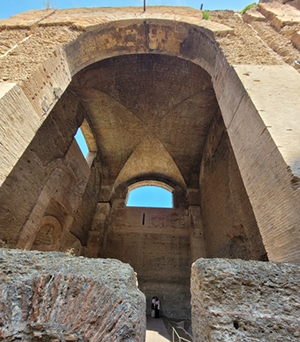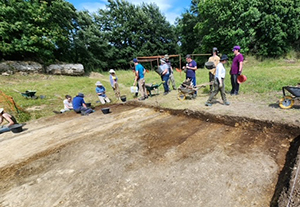Traveling abroad can be far from a walk in the park. You are thrown into an alien environment where you probably don’t speak the language, your phone might not give you peak performance, and your personal boundaries are demolished. If you’re from a little country town in Michigan, like I am, you’ll become immediately aware when you step into a huge city like Rome, with a population of 3 million, that it can be a very dangerous place.
However, like any strange circumstance you find yourself in, it’s better to have a positive outlook on things and just roll with it every day. I find dwelling on the negatives will take a once-in-a-lifetime experience like this and turn it into a bad one. Traveling abroad exposes you to different people, food and situations, and whether you have a good or bad experience, there is always something important to learn that you can take with you to your next destination.
 Now, don’t let that scare you away. While adusting can sometimes be difficult, it’s
worth it. There are so many fantastic things we’ve seen, and it would be criminal
not to mention the food we’ve had! You can’t experience Italy without trying some
freshly made pasta. I’m here to tell you, every time I walked into a restaurant and
ordered a pasta dish, my heart sang with just how delicious it was. We went to one
amazing restaurant called Secondo Tradizione, and I ordered a pasta dish with pork
jowl and artichokes. Delicious is an understatement. It was divine! Now, if you’re
like me, your body will protest the idea of endless pasta. I found it takes a little
bit of effort to find a place with a focus on something else, but we found a place
in Viterbo whille out with our guide Paola. I needed a salad, but when I was served
a delicious steak (right) with a little bit of greens and cheese with a balsamic drizzle, I absolutely couldn’t
complain!
Now, don’t let that scare you away. While adusting can sometimes be difficult, it’s
worth it. There are so many fantastic things we’ve seen, and it would be criminal
not to mention the food we’ve had! You can’t experience Italy without trying some
freshly made pasta. I’m here to tell you, every time I walked into a restaurant and
ordered a pasta dish, my heart sang with just how delicious it was. We went to one
amazing restaurant called Secondo Tradizione, and I ordered a pasta dish with pork
jowl and artichokes. Delicious is an understatement. It was divine! Now, if you’re
like me, your body will protest the idea of endless pasta. I found it takes a little
bit of effort to find a place with a focus on something else, but we found a place
in Viterbo whille out with our guide Paola. I needed a salad, but when I was served
a delicious steak (right) with a little bit of greens and cheese with a balsamic drizzle, I absolutely couldn’t
complain!
I’ve made it my life goal to see as many wonders our world has to offer as possible, and many of those are found here in Italy. One of the world’s greatest civilizations, Ancient Rome, have left their 2,000 year old footprints all over this country and beyond. Whether you are visiting the renowned Colosseum, or are just walking the streets of Rome and stumble across the beautiful, ancient remnants the city has woven itself around, there’s endless spectacular sights to see.
 We’ve all grown up seeing pictures of the great things Ancient Romans have left behind.
We’ve heard the stories of Pompeii and the gladiator fights in the Colosseum. However,
what I was most surprised by was the physical sensation I experienced when walking
these ruins, and sensation caused by their sheer size. The first time this happened
was when I was walking through the Baths of Caracalla (right). I knew these baths would be expansive, since they were a community facility where
people would meet, do business, eat, and bathe, but the way these gargantuan ruined
walls towered over me gave me a feeling you could never experience from a picture.
It was the first glimpse of the amazing building abilities the Roman’s possessed,
and I stood there, shocked that such a structure could have been built in 216 AD.
We’ve all grown up seeing pictures of the great things Ancient Romans have left behind.
We’ve heard the stories of Pompeii and the gladiator fights in the Colosseum. However,
what I was most surprised by was the physical sensation I experienced when walking
these ruins, and sensation caused by their sheer size. The first time this happened
was when I was walking through the Baths of Caracalla (right). I knew these baths would be expansive, since they were a community facility where
people would meet, do business, eat, and bathe, but the way these gargantuan ruined
walls towered over me gave me a feeling you could never experience from a picture.
It was the first glimpse of the amazing building abilities the Roman’s possessed,
and I stood there, shocked that such a structure could have been built in 216 AD.
Being able to finally experience the landmarks that we all know of, like the Colosseum and Pompeii, were truly surreal experiences. Although I discovered that some of my favorite places to visit were sites off the beaten path, to which I am grateful that the Study Abroad Association made time for us to visit along with the tour guides that helped to underline the significance of the sites. Places like Herculaneum and Ostia Antica had just as much to offer as the other touristy sites, while also having a certain intimacy that is lost amongst the crowds at those other locations.
Not only were these excavated cities interesting to visit in their own right, but having this preview before engaging in our own archaeological dig site helped to give perspective as to how our own work could potentially develop. Of course with our own limited time of five days on a dig site we will never excavate to that extent, but being able to see how the process begins and the labor involved gives new appreciation to how much time and effort a site like Pompeii would take.
 I knew that archaeological work would not be anything like it is shown to be in movies
like “Indiana Jones,” where the artifact is sitting on a pedestal waiting to be discovered,
but instead involves months and even years of thankless work digging and moving dirt.
However that is part of the satisfaction in the work. There is no clear outline as
to what exactly you will find or that you will even find anything at all. Being able
to adjust your expectations on what is below you is critical for anyone looking to
pursue this type of career, and indeed is part of the allure. What would be the point
of excavating if you already knew exactly what you were going to dig up?
I knew that archaeological work would not be anything like it is shown to be in movies
like “Indiana Jones,” where the artifact is sitting on a pedestal waiting to be discovered,
but instead involves months and even years of thankless work digging and moving dirt.
However that is part of the satisfaction in the work. There is no clear outline as
to what exactly you will find or that you will even find anything at all. Being able
to adjust your expectations on what is below you is critical for anyone looking to
pursue this type of career, and indeed is part of the allure. What would be the point
of excavating if you already knew exactly what you were going to dig up?
This entire experience has truly been a great learning lesson in so many ways and I am thankful to WCC for giving me the opportunity to develop both personally and academically through this study abroad trip. From interacting closely with those of a different culture as well as fellow students, to visiting museums and landmarks that contain thousands of years of history, and finally with being able to personally excavate the remnants of those we have studied. Receiving this first-hand experience has been a great way to kick off an academic career in the field of anthropology or history!
Tags: Study Abroad
